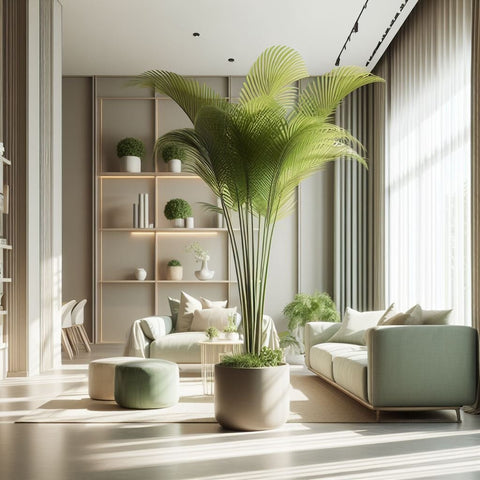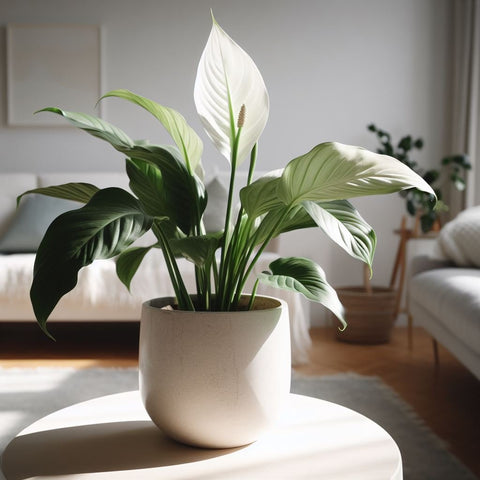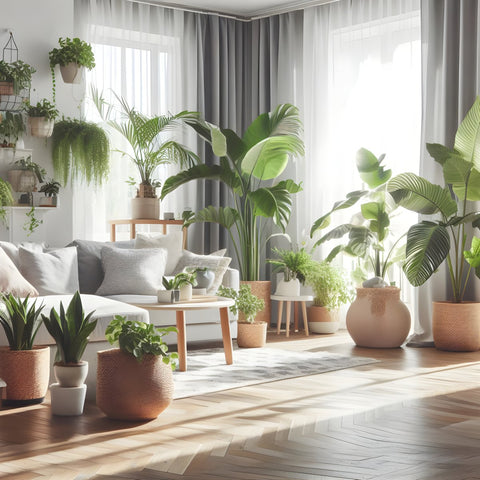Unlock the secrets to successful parlour palm plant care with our comprehensive guide. Learn about its history, ideal growing conditions, propagation techniques, pruning tips, common pests, and diseases. Discover the benefits of having this indoor houseplant and get answers to frequently asked questions. With our expert advice, you'll be able to nurture a healthy and thriving parlour palm plant in your home. Read on to learn more!
Introduction to the Parlour Palm Plant
The parlour palm plant, scientifically known as Chamaedorea elegans, is a popular choice for indoor houseplants. Its elegant and delicate appearance, along with its reputation for being adaptable and easy to care for, makes it a favorite among plant enthusiasts.

History and Origins of the Parlour Palm Plant
Originally from the rainforests of Mexico and Guatemala, the parlour palm plant has a rich history dating back centuries. It was first discovered by European explorers in the 19th century and quickly gained popularity as a decorative plant in Victorian parlors.
Why the Parlour Palm Plant is a Popular Indoor Houseplant
The parlour palm plant's popularity as an indoor houseplant can be attributed to its many desirable qualities. Not only does it add a touch of greenery and elegance to any space, but it also thrives in low light conditions, making it an ideal choice for rooms with limited natural light.
Parlour Palm Plant Care
Proper care is essential for the healthy growth and longevity of any plant, and the parlour palm plant is no exception. Understanding its specific needs and requirements will help you ensure its well-being and maintain its vibrant appearance.
Light Requirements for the Parlour Palm Plant
The parlour palm plant thrives in indirect or filtered light. It prefers bright, indirect light, but can also tolerate lower light conditions. Placing it near a north-facing window or in a room with filtered light will provide the optimal lighting conditions for its growth.

Ideal Soil Conditions for the Parlour Palm Plant
Well-draining soil is crucial for the parlour palm plant's health. It requires a soil mix that allows excess water to drain freely, preventing the roots from sitting in standing water. A mixture of peat moss, perlite, and a small amount of sand provides the ideal balance of moisture retention and drainage.
Watering Tips for the Parlour Palm Plant
Proper watering is vital to avoid overwatering or underwatering the parlour palm plant. It is best to water the plant when the top inch of soil feels dry to the touch. Ensure thorough watering, allowing water to flow out of the drainage holes, and discard any excess water from the saucer to prevent root rot.
Temperature and Humidity Requirements for the Parlour Palm Plant
The parlour palm plant thrives in temperatures between 60-80°F (15-27°C). It prefers moderate to high humidity levels, which can be achieved by placing the plant in a well-humidified room or using a humidifier. Avoid exposing the plant to drafts or sudden temperature changes.
Fertilizing the Parlour Palm Plant
The parlour palm plant benefits from regular fertilization to ensure it receives the necessary nutrients for healthy growth. Use a balanced fertilizer specifically formulated for indoor plants. Apply the fertilizer according to the instructions on the packaging, typically every two to four weeks during the growing season.

Parlour Palm Plant Propagation
Propagation allows you to expand your collection of parlour palm plants and share the beauty of this plant with others. There are several methods of propagating the parlour palm plant, each with its own set of steps and requirements.
Propagating the Parlour Palm Plant through Division
Dividing a mature parlour palm plant is an effective way to propagate it. Carefully separate the plant into individual clumps, ensuring each division has roots and healthy foliage. Plant the divisions in separate pots using a well-draining potting mix and provide proper care to promote their growth.
Propagating the Parlour Palm Plant through Offsets
Offsets, also known as pups or baby plants, are small plantlets that develop around the base of the parent plant. Gently remove the offsets from the parent plant and plant them in separate pots with a suitable potting mix. Keep the soil moist and provide a warm, humid environment to encourage their growth.
Propagating the Parlour Palm Plant through Seeds
Seed propagation is a slightly more challenging but rewarding method of propagating the parlour palm plant. Collect mature seeds from the plant, soak them in water for a few hours, and then plant them in a seed tray or pots filled with a well-draining seed-starting mix. Keep the soil consistently moist and provide warmth and indirect light for successful germination.
Pruning the Parlour Palm Plant
Pruning is an essential part of parlour palm plant care, allowing you to maintain its desired shape, remove dead or damaged foliage, and promote healthy growth. Follow these steps for effective pruning:
- Identify any dead, brown, or yellowing fronds and remove them at the base of the plant.
- Trim back overcrowded foliage to improve airflow and prevent the growth of pests or diseases.
- Use clean, sharp pruning shears to avoid tearing or damaging the plant.
- Wipe the blades with rubbing alcohol before and after pruning to prevent the spread of any potential diseases.

Common Pests and Diseases of the Parlour Palm Plant
Like any plant, the parlour palm plant is susceptible to certain pests and diseases. Being vigilant and monitoring your plant's health will help you catch any issues early and take appropriate measures for treatment.
Identifying and Treating Common Pests that Affect the Parlour Palm Plant
Some common pests that can infest the parlour palm plant include spider mites, mealybugs, and scale insects. Check the undersides of the leaves and along the stems for any signs of these pests. Use organic insecticidal soap or neem oil for effective treatment, following the instructions on the product label.
Recognizing Signs of Diseases and Taking Appropriate Measures for Treatment
The parlour palm plant is generally resistant to diseases, but it can occasionally develop fungal or bacterial infections. Watch out for symptoms such as leaf spot, root rot, or yellowing foliage. Remove affected leaves, improve air circulation, and adjust watering practices to prevent the spread of diseases.
Troubleshooting Common Issues with the Parlour Palm Plant
Despite your best efforts, you may encounter some issues with the parlour palm plant. Here are some common problems and ways to address them:
Yellowing or Browning of the Parlour Palm Plant's Leaves
Yellow or brown leaves can be a sign of overwatering, underwatering, or nutrient deficiencies. Assess your watering habits and adjust accordingly. Ensure the plant is receiving adequate light and address any nutrient deficiencies through appropriate fertilization.
Wilting or Drooping Leaves of the Parlour Palm Plant
Wilting or drooping leaves may indicate underwatering or a lack of humidity. Check the moisture level of the soil and adjust your watering routine. Increase humidity by misting the leaves, using a humidity tray, or placing the plant in a more humid environment.
Stunted Growth or Lack of New Growth in the Parlour Palm Plant
Stunted growth can be a result of insufficient light, improper watering, or nutrient deficiencies. Assess the plant's light conditions and make necessary adjustments. Ensure you are providing adequate water and nutrients. Consider repotting the plant into a slightly larger container with fresh soil to promote new growth.

Benefits of Having a Parlour Palm Plant
The parlour palm plant offers numerous benefits, making it an excellent choice for indoor spaces. Some of the key advantages include:
Air Purification Properties of the Parlour Palm Plant
The parlour palm plant is known for its air-purifying qualities. It helps remove toxins and pollutants from the air, creating a healthier indoor environment for you and your family.
Aesthetical Value and Enhancing Indoor Spaces with the Parlour Palm Plant
With its lush, green fronds and graceful appearance, the parlour palm plant adds a touch of natural beauty to any room. It can complement a variety of interior styles and help create a serene and tranquil atmosphere.
Frequently Asked Questions about the Parlour Palm Plant
Q: How often should I water my parlour palm plant?
A: Proper watering frequency depends on factors such as temperature, humidity, and potting mix. Generally, you should water the parlour palm plant when the top inch of soil feels dry.
Q: Can I place my parlour palm plant in direct sunlight?
A: No, the parlour palm plant prefers indirect or filtered light. Direct sunlight can scorch its leaves.
Q: How tall can a parlour palm plant grow?
A: In ideal conditions, the parlour palm plant can reach a height of 6-8 feet. However, it usually stays compact and manageable indoors.






























Comments (0)
There are no comments for this article. Be the first one to leave a message!